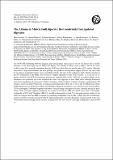Por favor, use este identificador para citar o enlazar a este item:
http://hdl.handle.net/10261/115226COMPARTIR / EXPORTAR:
 SHARE
BASE SHARE
BASE
|
|
| Visualizar otros formatos: MARC | Dublin Core | RDF | ORE | MODS | METS | DIDL | DATACITE | |

| Campo DC | Valor | Lengua/Idioma |
|---|---|---|
| dc.contributor.author | Ferrater, M. | - |
| dc.contributor.author | Perea, Héctor | - |
| dc.contributor.author | Rockwell, Thomas | - |
| dc.date.issued | 2014-04-28 | - |
| dc.identifier.citation | Geophysical Research Abstracts 16: EGU2014-12249 (2014) | - |
| dc.identifier.issn | 1607-7962 | - |
| dc.identifier.uri | http://hdl.handle.net/10261/115226 | - |
| dc.description | Ferrater, M. ... et. al.-- European Geosciences Union General Assembly 2014 (EGU2014), 27 april - 2 may 2014, Vienna, Austria.-- 1 page | - |
| dc.description.abstract | The NNW-SSE shortening between Eurasian and African plates takes place at rate of 4-6 mm/yr and is mostly absorbed, in the Iberian part, by the EBSZ (SE Spain). The Alhama de Murcia fault (AMF) is one of the faults in this system. It is generally considered that the AMF has a slow slip rate (on the order of 0.1 mm/yr, although associated to high uncertainties), but new geologic and geodetic investigations suggest that the slip rate could be an order of magnitude higher, more concordant with the slip rate of the Carboneras fault, which is located in the SW termination of the EBSZ. The evidence of higher slip rates for the AMF includes: 1) a slip rate of 1.5 mm/yr obtained with GPS measurements between the northern block of the AMF and the southern block of the Palomares fault (however, this value would be the sum of the slip-rates of both EBSZ faults although Palomares shows less morphological expression); 2) first estimations of lateral offsets in buried channels in paleoseismic 3D trenches, where an upper Pleistocene to Holocene paleochannel is offset up to 10 m; and 3) different age (from middle Pleistocene to Holocene) surface morphologies (channels and terraces) are offset between 10 and 100 m. U/Th on pedogenic carbonates together with other classical dating techniques is used to constrain the age of these offsets. To be the higher slip rate confirmed, the seismic hazard of the AMF, that struck Lorca with a catastrophic earthquake in 2011 with 9 fatalities (Mw5.2), should be thoroughly revised. Previous paleoseismic studies in the study area suggest that the AMF is capable of producing earthquakes of up to Mw 7. High slip rates would imply shorter recurrence periods associated with the fault and therefore, the time-dependent seismic hazard in the area would drastically be enlarged as the seismic catalogue does not show any of such large earthquakes in the last 500 yr | - |
| dc.publisher | European Geosciences Union | - |
| dc.rights | openAccess | - |
| dc.title | The Alhama de Murcia fault slip-rate: first constraints from updated slip-rates | - |
| dc.type | póster de congreso | - |
| dc.relation.publisherversion | http://meetingorganizer.copernicus.org/EGU2014/posters/14602 | - |
| dc.date.updated | 2015-05-14T11:37:42Z | - |
| dc.description.version | Peer Reviewed | - |
| dc.language.rfc3066 | eng | - |
| dc.rights.license | https://creativecommons.org/licenses/by/3.0/legalcode | - |
| dc.type.coar | http://purl.org/coar/resource_type/c_6670 | es_ES |
| item.fulltext | With Fulltext | - |
| item.openairecristype | http://purl.org/coar/resource_type/c_18cf | - |
| item.cerifentitytype | Publications | - |
| item.grantfulltext | open | - |
| item.openairetype | póster de congreso | - |
| Aparece en las colecciones: | (ICM) Comunicaciones congresos | |
Ficheros en este ítem:
| Fichero | Descripción | Tamaño | Formato | |
|---|---|---|---|---|
| Ferrater_et_al_2014.pdf | 36,72 kB | Adobe PDF |  Visualizar/Abrir |
CORE Recommender
Page view(s)
266
checked on 22-abr-2024
Download(s)
94
checked on 22-abr-2024
Google ScholarTM
Check
Este item está licenciado bajo una Licencia Creative Commons

